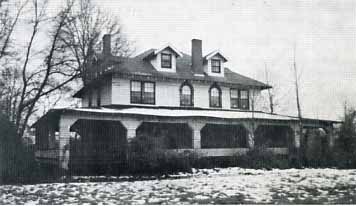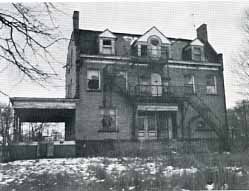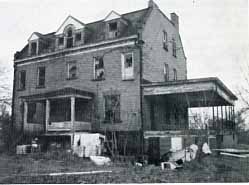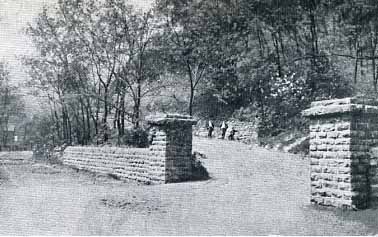
The Robert Garland House facing the Ohio river from Sylvan Crest, Center Township.
Click Here to Return To MilestonesVol 6 No 3

Printed articles often awaken memories and invoke sequels issuing from the minds of reflective readers. Such a sequel received its impetus from an article found in a former number of Milestones (Volume 5, No. 1) entitled "1764: Henry Bouquet's March Through Beaver County." The article was accompanied by a cut of a painted portrait of Colonel Bouquet, an admirably executed copy from the original and only portrait in America of the colonel, taken from life by the eminent eighteenth century painter, John Wallaston.
The sequel is embodied in a communication received from the distinguished artist who produced the copy painting, formerly the painter of many fine portraits hanging in Pittsburgh, Lois Weissflog, now retired and living in Sun City, Arizona. Her friendly and candid letter carried a surprising message regarding her girlhood impressions and associations with Beaver County scenes and people. Part of her letter follows.
"Your article about Bouquet's march through Beaver County was very interesting to me...
Some of my relatives and friends lived in that part of the county. When I was a child, I visited my mother's cousin who lived on a farm on Dutch Ridge Road. She later moved to Monaca and lived in a big house on top of a hill called Sylvan Crest [really in Center Township]. It overlooked the [Ohio] River and bridges to Rochester and Beaver. Other relatives lived in these two towns... Getting back to Sylvan Crest... the house belonged to Robert Garland, the father of Daylight Saving Time... It had been empty for a long time, and the estate was in disrepair. I remember the ruins of what must have been a gorgeous swimming pool nestled in the rocks of the hillside. We used to take our lunch to the brow of the hill and to sit and watch the trains crossing the R.R. bridge below. Those were some of my favorite memories..."
The foregoing account of the artist's connections with Beaver County was wholly unexpected and surprising, and it opened a new area of interest by introducing the Robert Garland episode. The presence of the man and his family upon Sylvan Crest, in prior years, is mentioned in the Bicentennial book, Center, but particulars of his history were only hinted.
Robert Garland presents a fine example of an immigrant boy who rose to a position of national prominence and an industrialist of note. County Tyrone, in Ireland, was his birthplace in 1862, a son of a veteran of the Crimean war, in an Irish artillery regiment and of Scottish descent. The family came to the United States in 1877 and settled in Pittsburgh. Robert Garland found employment as a clerk in the office of the Oliver Iron and Steel Company and rose, by steady advancement, to the position of sales manager of that company. By the time he had attained his early thirties, he had established his own company, the Garland Manufacturing Company, to fabricate specialty products for the builders' hardware trade, electrical conduits, chains, etc. Garland participated in many civic activities, being elected a member of Pittsburgh City Council which he served for six consecutive terms, eighteen years of which he was chairman of the council's finance committee. As a member of Pittsburgh's Chamber of Commerce, of which he was twice president, he was known as a farsighted business builder and was elected a member of the U. S. Chamber of Commerce. A member of the boards of trustees of two colleges, he kept abreast of the trends of education, as also directorships of two city banks carried prestige in financial circles. Success brought him memberships in Pittsburgh's uppermost business men's clubs, as the Duquesne Club, the University Club, and the Pittsburgh Athletic Association. Several exclusive golf and country clubs counted him among their members.
All of this recognition was directed toward a man upon whom public approbation rested as a weighty responsibility to use his talents in the public interest. During World War 1, Garland was appointed chairman of the War Resources Committee of District No. 5 (a government sponsored activity to aid industry by coordinating resources and materials) with oversight of Western Pennsylvania, Western Maryland, and all of West Virginia. Having long advocated the advantages of advancing the clocks one hour during the summer months, in order to take advantage of the longer use of daylight, the war effort in 1917-1919 offered an opportunity to test Garland's theory of Daylight Saving. Through this man's efforts, the Boreland bill in the Congress of the United States was enacted into law on March 18, 1918.
This, of course, was not a unique idea in the world. An early proponent had been Benjamin Franklin during his residence in Paris as commissioner to France of the American Congress at the time of the American Revolution. In his usual way of compiling statistics, he computed that the shop keepers alone in Paris, in this way might save ninety-six million seventy-five thousand candles annually. It seems strange that Franklin neglected to calculate the number of tradesmen chandellers all over France and Europe who would have been thrown out of employment by this great saving scheme. Franklin's own father and brothers were chandlers in Boston. Both England and Germany adopted their own Daylight Saving plans as war measures. Garland, however was nationally recognized as the American father of Daylight Saving time.
Garland's contributions to the American economy and the war effort were given official recognition by President Woodrow Wilson, who sent him the pen with which he signed the measure into law, also the pens used by the vice-president and the speaker of the House of Representatives. Congress repealed the Daylight Saving act in August, 1919, but the United States Chamber of Commerce influenced many cities to perpetuate the practice independently.
When World War 11 burst upon America with the bombing of Pearl Harbor, an impetus like a wave of concussion from the bomb bursts rolled across the nation, and all industry went into high gear for massive production. Daylight Saving again came to the front as an incentive to the total war effort. In 1942, President Franklin D. Roosevelt signed into law a bill passed by Congress, making Daylight Saving a legal guideline of American life, not alone in industry and government but in all legal procedures, courts of law, contracts, and rules of evidence. President Roosevelt sent the pen whereby he signed the document to Mr. Garland, with his warmest sentiments. These official pens from two presidents thus became historically interesting relics. They were presented by the distinguished recipient to the Historical Society of Western Pennsylvania, in Pittsburgh, where they are preserved.
Three younger Garland brothers, John, Charles, and Thomas, followed the rest of the family to Pittsburgh all becoming employees of the Oliver Iron and Steel Company. Later John and Charles became engaged in the Garland Manufacturing Company enterprises. Thomas went to an English university, entered the priesthood of the Episcopal Church and became the Episcopal bishop of Philadelphia. The general offices of the Garland Corporation (the designation of the expanded enterprises) were in the Grant Building, in Pittsburgh, and the main plant was located in West Pittsburgh, on the Beaver River in Lawrence County.


The spacious porch-encircled house that Robert Garland built atop the lofty bluff named Sylvan Crest sits in the very northeastern corner of Center Township (Moon Township until 1914) upon a ninety-three acre tract, extending from the narrow valley traversed by highway Route 51, over the summit and dropping nearly perpendicularly to the railroad tracks at the river's edge. The land was bought from James H. Welch, who operated coal and clay mines beneath the hill, as well as a large brick manufacturing plant. It included the Welch brick house adjacent to Robert Garland's house, which John Garland later occupied and owned for a while, and conveyed to Robert after a death in his family, in 1918. The-large Robert Garland house must have been constructed after 1906, probably in 1908, and was intended as a country summer retreat, the family's city residence being on Inverness Street, on the hill above the then -fashionable Fifth Avenue, in Pittsburgh. Much entertaining was carried on at Sylvan Crest or "the farm," as the family knew it. High above the town of Monaca and commanding the impressive panorama of many miles' extent on both the Ohio and Beaver Rivers, the view is a sight to remember.
The modern 4-lane highway, Pa. Route 18, has obliterated most of the former road. Traces of the private road that reached the hilltop mansions diverged to the right from the public road just south of the CenterMonaca Borough line (beyond the P. & L. E. Railroad underpass). It shelved into the precipitous face of the hill as it climbed and executed two "hairpin" turns that can only be described as a "switch-back." Massive masonry retaining walls with crenelated tops rise several feet above the roadbed at the bends, reminiscent of the approaches to many English or Scottish highland castles. The stone was quarried from the hillside very near the road. The prospect while overlooking the sheer two-hundred foot drop is a little frightening; yet, at no place is the climb of the road more than an eight per cent grade. Even so, this exercise in the daily hillclimb must have been a challenge to the motor cars of the era prior to the 1920s.
Thus, in a roundabout and unexpected manner, we have been reminded that Beaver County, in the forepart of this century, had a very interesting resident and part time citizen of national fame and prominence, although his official residence, from necessity, was in Pittsburgh, due to his political involvement.
For various reasons, the corporate partnerships were dissolved in the late thirties. The economic conditions of the depression years of the thirties, also the changed marketing conditions requiring different types of electrical conduits and builders' hardware than the line previously produced by Garland's plant, the infeasibility of retooling the shop, plus the loss in 1931 of John, the next senior partner to Robert, and the fact that all were reaching advanced ages, all conspired to halt operations. Mrs. Robert (Alice Bailey) Garland died in 1939, and Robert Garland passed away, in his eighty-seventh year, in 1919.

An early postcard view of the entrance to the lane leading to "Garland's Hill". To the side is Pennsylvania Avenue Extension, later to become Route 18. The entire scene is now obscurd by the four-lane Route 18. The gate was about 100 yards south of the railroad trestle.
The article on "1764: Bouquet's March Through Beaver County" with the cut of Bouquet's portrait, is found in Milestones, Volume 5, No. 1 [Winter], 1979, continued in Volume 5, No. Z 1979. Acknowledgement is hereby made to Mrs. Lois Weissflog of Sun City Arizona, writer of the letter which evokes the memoir of Robert Garland and connections of his family with Beaver County in former times.
Interviews with some members of the Garland family, yet in the Pittsburgh area, have been pleasureable. A daughter of Robert Garland, a daughter of John, and a son of Charles have generously contributed much information that supplements and corroborates the formal records. Their memories of their youthful vacation days spent at Sylvan Crest have been helpful and enjoyable.
A concise biographical sketch of Robert Garland is found in Frank Harper, ed., Pittsburgh of Today, 5 vols. New York 1931, 4.456.
Articles relating to Daylight Saving:
PIttsburgh Press, March 30, 1935, ibid, February 7, 1936,
ibid., April 19, 1979,- ibid., April 26, 1956, article by George Swetnam, "Pittsburgh's Father Time. " Greater Pittsburgh magazine, April, 1935, p. 7, 19.
Books and published records:
Robert Garland, Ten Years of Daylight Saving from the Pittsburgh Standpoint, Pittsburgh, 1920.
Robert W. Hughes, The Story of Daylight Saving Time, Pittsburgh, 1936.
Albert Henry Smyth, The Writings of Benjamin Franklin, 10 vols, New York, 1905-0, "An Economical Project, " 9: 183-9.
Carl Van Doren, Benjamin Franklin, New York, 1938, p. 710.
Pittsburgh City Directory, 1938
Pennsylvania Pamphlet Laws, No. 195 (S B 738) An Act Amending the Act of April 13, 1887 [PL 211 Approved - The 26th day of August, A.D. 1965 [by] William W. Scranton, Governor.
Official rccords:
Beaver County Recorder of Deeds, D.B. 260,
p. 156-8, D.B. 267, p. 424,- D.B. 269, p. 266-7.